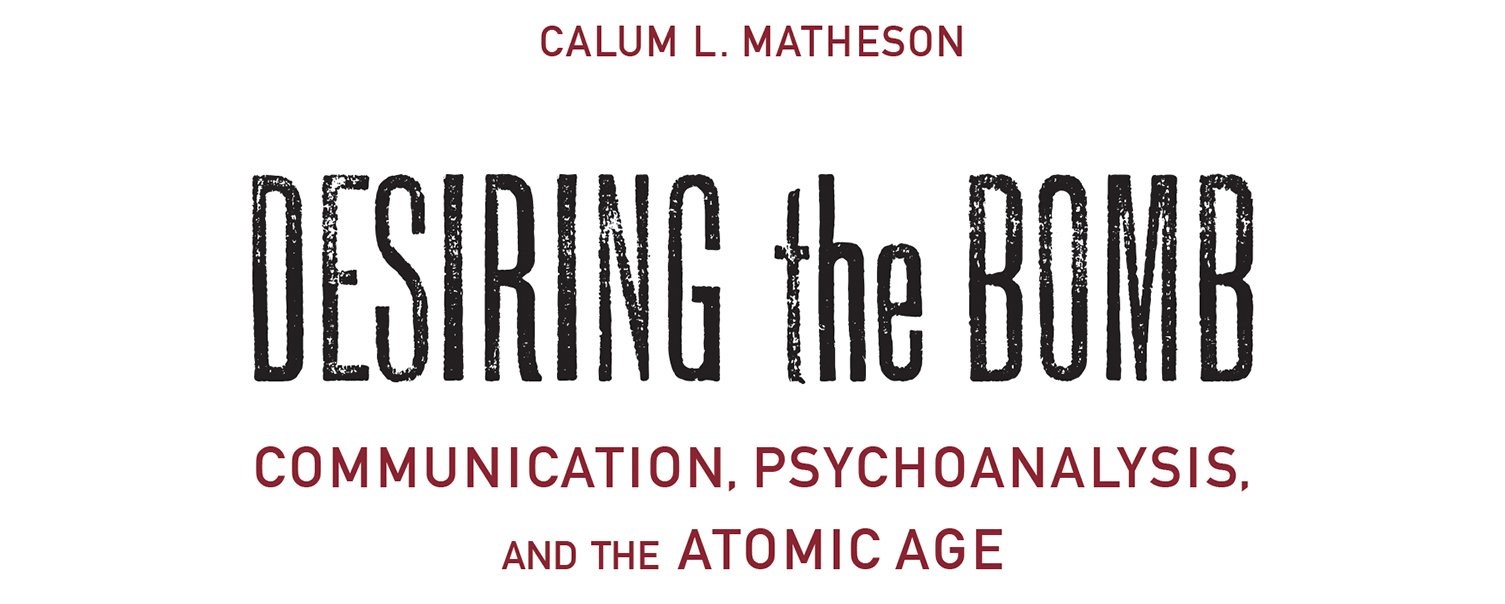
Reviewed by Sean Steele (University of Findlay)
The Overview
"We still live in the shadow of the Bomb...Nearly everyone on Earth is inundated by the cultural apparatuses spawned by the nuclear state" (p. 3). This statement, made by Calum Matheson in his 2019 work Desiring the Bomb, summarizes well why “the Bomb” (Matheson’s term for the threat of nuclear war as a symbol) is a prime metaphor for understanding human society in the twentieth and twenty-first centuries. Matheson’s project – “to examine the Bomb as a figure of both horror and desire, not only for what it reveals about the persistent cultural echoes of the Atomic Age, but also to uncover its implications for language itself" (p. 14) – takes shape under two intellectual approaches: rhetorical theory and psychoanalysis
There are two reasons Matheson picks the crossroads of these fields to produce his interdisciplinary inquiry. First, "The balance between individual actors, contingent events, and the structural conditions of possibility is one reason why psychoanalysis and rhetoric should be understood as inextricably connected projects" (p. 6). In other words, psychoanalysis focuses on the systems, while rhetoric focuses on specific events and players within the system
Second, each field contains tools that help explore what the Bomb as an organizing metaphor means for modern American society: Jacques Lacan’s concepts of the Real and the death drive, and the rhetorical concept of the Sublime (p. 14-20). By synthesizing these analytical tools to uncover various aspects of the Bomb’s impact on modern society, Matheson ultimately argues that the “concealment thesis” - "belief that a sanitized vocabulary upholds the complex of nuclear destruction by concealing the horror of nuclear war" (p. 10) – does not adequately account for cultural fascination with the Bomb, and thus cannot end “the nuclear security state” which inflicts violence upon large groups of people because it fails to consider the “underlying ecology of desire that sustains” nuclear discourse (p. 13). In other words, activists and scholars cannot end the Bomb’s cultural and political influence (and thus the existential threat of nuclear war) by merely using graphic, gruesome language to paint a more accurate portrait of the apocalyptic horrors such war could unleash – this approach neglects the role desire plays in society’s continuing fascination with the Bomb.
Matheson organizes his work around two cycles that are represented by “fort-da” (here-gone). The phrase “fort-da” originates in an experiment undertaken by Freud, who observed a child deriving pleasure from making an object appear (“fort”) and disappear (“da”). Freud concluded that presence and absence were not what produced pleasure for the child, but rather the ability to control whether the object is present or absent. For the purposes of studying the Bomb, Matheson remarks: "Attempts to mediate nuclear war can be understood through this frame” – that is, fort-da – “as efforts to impose some predictability over the chaotic intrusion of the real" (p. 16). While this fort-da dynamic will be important in discussions of chapters 2 and 4, Matheson also uses “fort-da” as a metaphor for the organization of the book itself. Personally, while I thought it was a sufficient organizing principle, it did not feel like a necessary move, and it unfortunately split up Matheson’s exploration of society’s two main responses to the Bomb – war games and survivalism.